Wuyi Mountain Scenic Area is located in Wuyishan City, Nanping City, Fujian Province. It is one of the first batch of national key scenic areas and a national 5A-level tourist attraction. In December 1999, it was listed in the World Heritage List by UNESCO, becoming a "World Natural and Cultural Dual Heritage". The planned area of the scenic spot is 79 square kilometers, with an average altitude of 350 meters. It features a typical Danxia landform and is known as "Clear Water and Red Mountains" and "The Most Beautiful Scenery in Southeast China". There are numerous clear springs, waterfalls, mountain streams and rivulets in the area. The Nine-Bend River originates from the southern foot of Huanggang Mountain in Wuyi Mountain Nature Reserve, with a total length of 60 kilometers, flowing 9.5 kilometers through the scenic area.
History and Culture
Wuyi Mountain is the cradle of Zhuzi Neo-Confucianism and an important base for the world's research on Zhuzi Neo-Confucianism and even Eastern culture. Since the Song and Ming dynasties, great Confucian scholars of Neo-Confucianism such as Yang Shi, You Zuo, Zhu Xi and Wang Yangming have long lingered and resided here. Zhu Xi founded a new school of Neo-Confucianism in Wuyi Mountain — Min Xue, and became a great master of Neo-Confucianism. Up to now, Wuyi Mountain still retains numerous cliff inscriptions by outstanding ancient figures such as Zhu Xi, with more than 450 rock carvings since the Song Dynasty.
Early human activities in Wuyi Mountain can be traced back to the Neolithic Age about 10,000 years ago. The fragments of cotton cloth in burial objects such as hanging coffins in cliffs and rainbow bridge planks are the earliest physical objects of cotton textiles found in China so far. The site of the Western Han Minyue King City, covering an area of 480,000 square meters, is the most well-preserved Han Dynasty ancient city south of the Yangtze River in China. Its construction location, layout, architectural technology and style are unique, making it a typical representative of ancient southern cities in China.
In addition, Taoism and Buddhism culture in Wuyi Mountain are prosperous. As early as the mid-8th century, the Tianbao Palace of Taoism was built in Wuyi Mountain and listed as the "Shengzhen Yuahua Cave Heaven" among the 36 Taoist caves; in the mid-10th century, Wuyi Mountain was designated as a Taoist mountain by imperial order, and Chongyou Temple was one of the nine famous temples in the country. After the 11th century, Wuyi Mountain became one of the "Eight Famous Buddhist Mountains of the Chinese nation", with religious and cultural sites scattered all over Wuyi Mountain. At its peak, as many as 187 temples, ancestral halls, palaces and academies were built.
Main Attractions
Tianyou Peak
Located in the center of the scenic area, it is connected to Xianyou Rock in the east, Qingyin Rock in the south and Xianzhang Peak in the west. Standing towering above the peaks with precipitous cliffs, it offers a grand view of the sea of clouds on clear days after rain or at dawn when the first light appears. Sometimes, the wonderful "Buddha's Light" can also be seen.
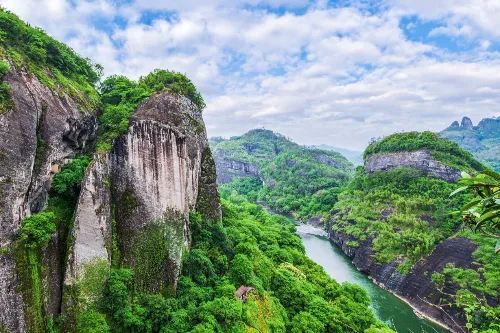
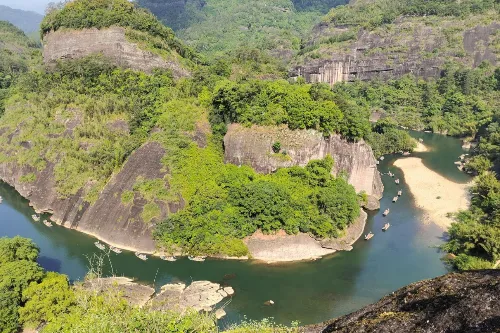
One-Line Sky
Also known as Single-Character Sky, it is located in a deep canyon south of the Second Bend River at the southern end of the Wuyi Mountain peaks. There is a huge rock slanting out to cover three adjacent caves, with a crack of more than 100 zhang (about 333 meters) on the top and less than 1 meter wide. Leaning into the cave, one can look up at the amazing scene of a line of sky light.

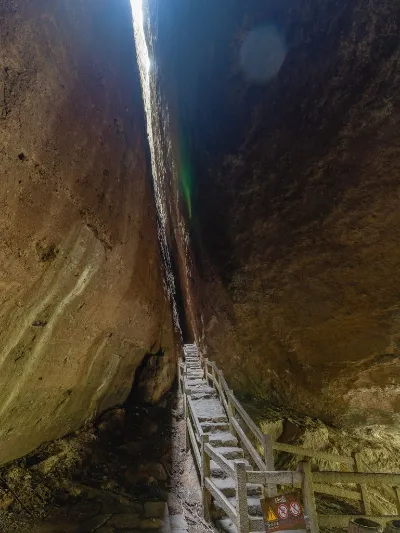
Taoyuan Cave
Located inside the Sixth Bend of Wuyi Mountain, this place is extremely deep and secluded. Stone cliffs lean against each other to form a gate; walking in winding paths, there are streams flowing under stone bridges, and the inside suddenly opens up into a flat and vast area, just like the "Peach Blossom Land" described by Tao Yuanming. It houses halls such as Sanqing Hall, Yuhuang Hall, Lingguan Hall and Mountain Gate.

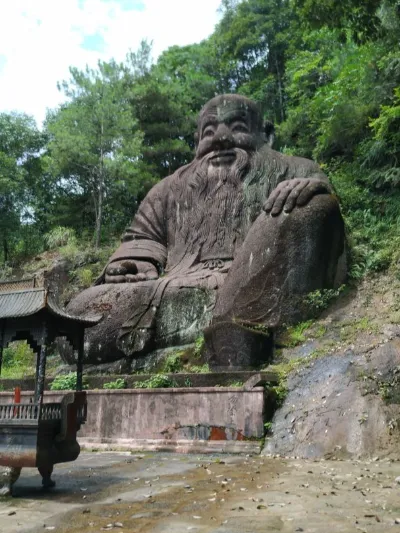
Yunwo (Cloud Nest)
Located at the foot of Tianyou Peak, it has more than 10 caves of various sizes. In the morning and evening of winter and spring, clouds and mist often drift out of the caves, wandering gently among the peaks and rocks, rolling and unfolding freely, changing unpredictably. Around it are other attractions such as Xiangsheng Rock (Sound-Rock), Danlu Rock (Cinnabar Stove Rock) and Xianji Rock (Immortal Trace Rock).
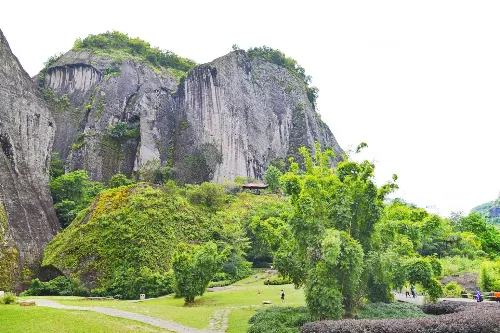
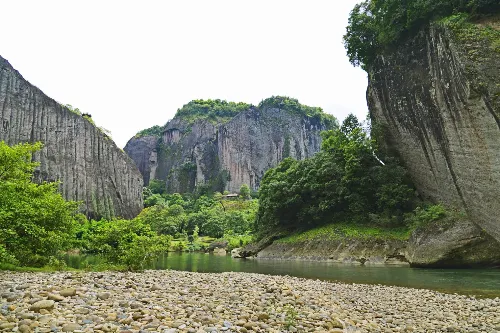
Wuyi Palace
Also known as Huixian Temple, Chongyou Temple and Wannian Palace, it is located at the southern foot of Dawang Peak (King Peak), facing the mouth of the Nine-Bend River in the front. It is the place where emperors of past dynasties offered sacrifices to Lord Wuyi and one of the six famous Taoist temples in the Song Dynasty. It contains attractions such as Song Street, Wuyi Mountain Historical Relics Exhibition Hall and Sanqing Hall.
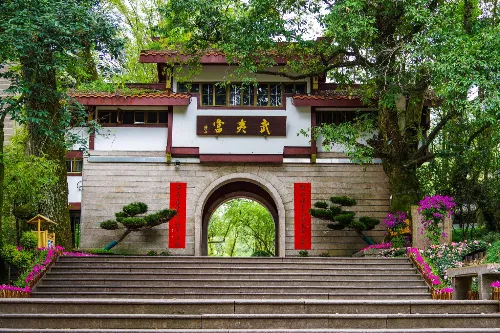
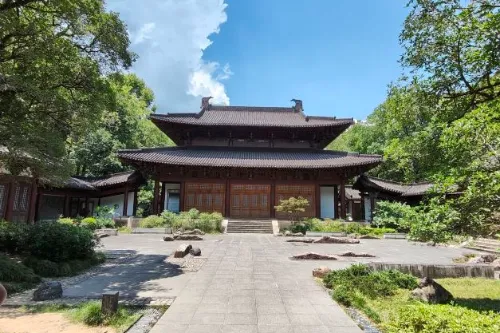
Da Hong Pao (Big Red Robe)
The peaks and rocks are steep, and the canyons are deep, featuring unique beauty of rocks and valleys. Some peaks and rocks stand alone, some lean obliquely, some tower high, some stack up, some split apart, with strange shapes and postures that are hard to describe. There are crisscross streams and hanging waterfalls in the mountains. The area includes attractions such as Xiabin Rock, Yingzui Rock (Eagle's Beak Rock), Jiulongke (Nine Dragon Valley), Tianxin Rock (Heavenly Heart Rock).

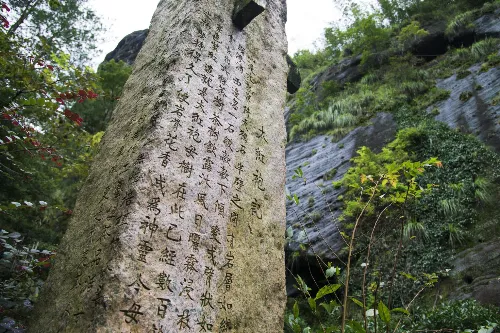
Water Curtain Cave
Located in the central part of Wuyi Mountain Scenic Area, the Water Curtain Cave, a core attraction of the scenic spot, is the largest cave in Wuyi Mountain and is known as "the most scenic spot in the mountains". Formed by rock collapse, it is more than 80 meters high and over 170 meters wide, protruding upward and concave downward. The cave is bright enough to accommodate a thousand people, shaded by red cliffs covered with inscriptions. The area also includes attractions such as Yanzifeng (Swallow Peak), Danxia Peak and Sanxian Shrine (Shrine of Three Sages).

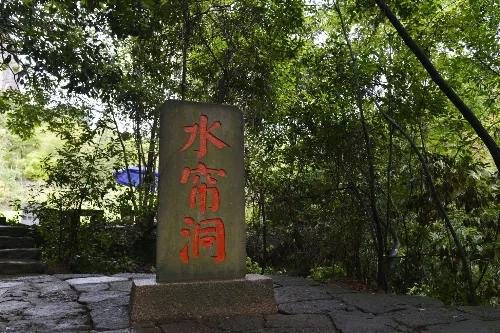
Nine-Bend River
Originating from Tongmuguan in Wuyi Mountain, it has a total length of 62.8 kilometers and flows eastward into Chongyang River. The lower reaches of 9.5 kilometers are bent into nine bends due to geological faulting, with eight shoals and five pools. Peaks and rocks stand on both sides of the river. Mountains surround the water, and water runs through the mountains, with red mountains and clear water forming a delightful contrast. Taking a bamboo raft tour is like being in a landscape painting gallery, pleasing to the eye and mind.
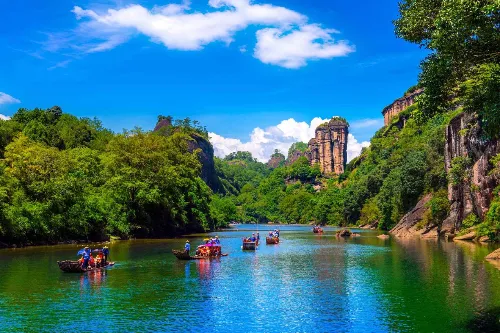
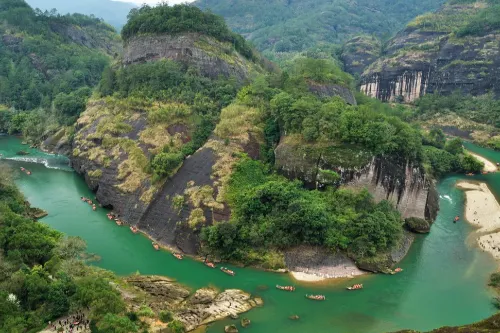
Travel Routes
One-Day Tour: Tianyou Peak → Tea Cave → Yuhua Peak → Yunwo → Snowflake Spring → Immortal Bathing Pool → Humajian Tianyou View → Yilan Pavilion → Taoyuan Cave → Saibu Rock (Suncloth Rock) → Yinping Peak (Hidden Screen Peak) → Tianyou Pavilion → Zhongzheng Park → Nine-Bend River Rafting → Wuyi Palace.
Two-Day Tour: Day 1: Tianyou Peak Scenic Area (visit Yunwo → Tea Cave → Yinping Peak → Tianyou Peak → Tianyou Pavilion, etc.) → Nine-Bend River Scenic Area (take a bamboo raft ride on the Nine-Bend River → Wuyi Palace → Song Street → Wuyi Tea Culture); Day 2: One-Line Sky → Wind Cave → Immortal's Pavilion → Eight Scenes of Huxiao (Tiger Roar) → Water Curtain Cave → Yingzui Rock → Tianchejia (Heavenly Cart Frame) → Jiulongke → Giant Buddha → Da Hong Pao Scenic Area.
Wuyi Mountain Loop Cycling Route: Start from Wuyi Square in Wuyi Mountain Resort, then cycle around Wuyi Mountain, passing through the North Entrance of the Scenic Area, Small Bamboo Forest, Lianhua Peak (Lotus Peak), Lantang Bridge, etc., and return to Wuyi Square in Wuyi Mountain Resort as the end point. The whole journey is about 50 kilometers.
Wuyi Mountain Scenic Area Hiking Route: Start hiking from the First Bend of the Nine-Bend River in Wuyi Mountain, first hike up to Nüyu Peak (Jade Lady Peak), then pass through attractions such as One-Line Sky and Huxiao Rock, and reach Xingcun Bamboo Raft Wharf as the end point. The whole journey is about 12 kilometers, taking about 6-7 hours to hike.
Travel Tips
- Pay attention to the weather of the scenic area in advance and choose a suitable time to travel. The roads are slippery on rainy days, so please pay attention to safety.
- If time permits, you can arrange a 3-day trip to slowly enjoy the beautiful scenery of the scenic area and deeply experience the local culture.
- When taking a bamboo raft ride, follow the guidance of the staff, keep your personal belongings safe and avoid them falling into the water.
- When tasting local food, you can choose according to your personal taste. If you are not good at eating spicy food, you can inform the restaurant in advance to put less chili when ordering dishes such as Langu Smoked Goose.
Notes
- Smoking is strictly prohibited in the scenic area, and it is forbidden to randomly damage vegetation and cultural relics and historic sites.
- Wear comfortable sports shoes when hiking, and avoid wearing high heels or slippers to prevent falls and injuries.
- Take sun protection and anti-mosquito measures when traveling in summer, and carry items such as sunscreen and mosquito repellent.
- Obey the order when taking transportation, keep your personal belongings safe, especially in crowded places.
- Book tickets and accommodation through official channels to avoid being deceived. Book in advance during peak tourist seasons such as holidays.
Transportation
- High-Speed Rail: Take Bus No. 6, 7 or 9 from Wuyishan North Station directly to the resort or the South/North Entrance of the scenic area; from Nanping Station, take K1 to get off at the South Entrance of the scenic area or bus stops along the resort, or take the Wuyi Tram to get off at the South Entrance of the scenic area.
- Airplane: After arriving at Wuyishan Airport, take Bus No. 6, 7 or 9 to the resort.
- Self-Driving: You can choose to enter the resort via [Jiuqu Toll Station] or [Wuyishan Toll Station].
- Parking Lots: There are parking lots at the South Entrance, North Entrance of the main scenic area and other attractions. The scenic area has also added temporary free parking lots such as Lanyuan Parking Lot and Shuixiu Parking Lot.
Opening Hours
March 1 - November 30: 06:30 - 18:00, latest entry at 16:30; December 1 - February 28 of the next year: 07:00 - 17:00, latest entry at 16:00.
Tickets
Tickets start from 70 yuan.
You can search for the official WeChat public account "中国武夷山" to get the latest updates or book tickets online. There are many types of tickets, please purchase according to your needs.
Online Booking
Click here to jump to the Trip.com ticketing platform for ticket purchase.


